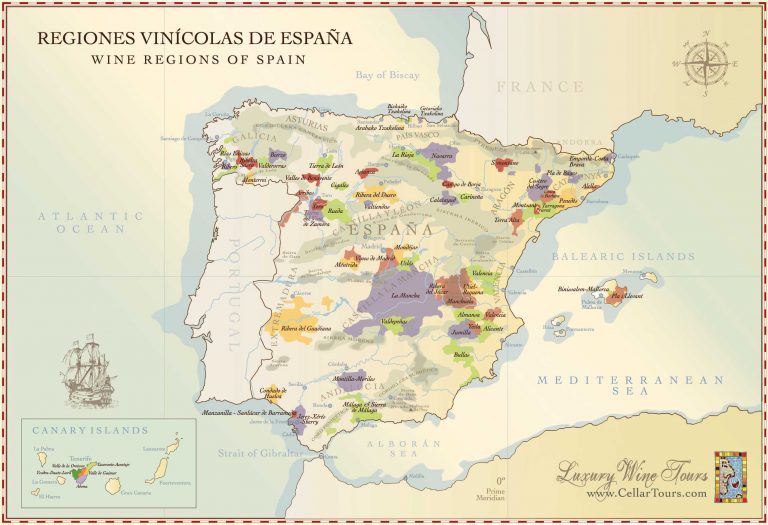Spain is fast becoming my “go to” country for great value, good quality wines, if you know where to look you can get some fabulous wines but you do need to be careful of mass produced ‘soft brand’ wines which come from across the Castilla-La-Mancha region – a region which produces vast swathes of grapes, many of which go into low cost, high volume wine where quantity tends to outweigh quality (although you can find boutique gems if you know where to look).
It struck me that most people if asked to name Spanish wines would probably come up with the same name: ‘Rioja’ and if pushed further some may then say ‘Sherry’ and possibly ‘Cava’ – certainly these are the most known (and widely available) on the High Street.
Now don’t get me wrong, I do love a good Rioja, but I’ve tasted my fair share of ho-hum ones too, which take advantage of the name. Quality and style do vary greatly but as a rule of thumb, depending on whether you like purer fruit flavours or prefer sweeter vanilla, coconut and smoky notes you should opt for either the younger wines (Joven, Crianza) or older (Reserva, Gran Reserva) wines respectively.
Cava is a much maligned wine in my opinion, many consumers don’t realise that Cava (unlike Prosecco, with which it is often (unfairly) compared), is actually a great value alternative to Champagne. It is made the saw way as Champagne (with the second fermentation in the bottle and lees ageing prior to disgorgement) but uses indigenous varieties Xarel-lo, Parellada and Macabeo instead of the better known Chardonnay, Pinot Noir and Pinot Meunier used in Champagne. I personally always opt for Cava over Prosecco it might be a few quid more expensive but is well worth it for the quality.
Then there is the great ‘divider of opinion’ Sherry (from the hot southern region of Jerez) made predominantly from the white Palomino grape. I do like a good sherry and have waxed lyrical on the virtues of sherry in any number of blog posts, so I won’t harp on here, but take my word for it, sherry is among the best value quality wines in the world. If you like a light bodied, savoury and bone dry wine then opt for a ‘Manzanilla’ or ‘Fino’ – a perfect match with olives. If you like a nuttier richer style, ‘Oloroso’ is a good bet, but the daddy if you have a sweet tooth is Pedro Ximénez and it’s absolutely gorgeous poured over ice cream!
But I have digressed long enough, there is much more to Spain than just Rioja, Cava and Sherry…..
While it is true to say that warm climate grapes tend to dominate in all but the cooler coastal regions, improvements in wine making during the last 20-30 years, coupled with a realisation of the need to seek out cooler climate vineyard sites (either those nearer coasts or at higher altitudes) and vast swathes of vineyard replanting, has thankfully seen a quantum leap in quality.
There is so much diversity within the many DO’s of Spain that there is undoubtedly a wine to appeal to everyone, no matter what your taste – with a plethora of styles and grape varieties to choose from.

Whites to look for....
The northern regions of Galicia and Pais Vasco are cool and damp and are very good places to start if you like fresh, aromatic white wines.
Arguably Spain’s best known white wine is found in Galicia in Spain’s verdant far north-east. Here in Rías Baixas, Albariño is the main grape and produces wines with aromas redolent of peaches, zesty citrus and lifted floral notes with crisp acidity and a slightly saline minerality. Producers are experimenting with the grape and these days you can also find barrel-aged versions which give added texture and weight.
Another Galician white to seek out is Godello – a rare grape increasingly growing in reputation. Once near extinction the grape has made a remarkable recovery and today is considered by many to have the potential to be Spain’s greatest white variety. Relatively high in acidity, with notes of fresh green apple and grapefruit/citrus these wines are crisp and dry and often also have a saline minerality. The best iterations currently can be found in the far east of Galicia in the substantially warmer and more inland Valdeorras DO.
Slightly further south and east is the Castilla y León region, here the standout white wine is found in Rueda – if you like Sauvignon Blanc then you’ll probably want to give this region a look. Indigenous variety Verdejo is the king of the white grapes here and is capable of extended ageing. Verdejo produces wines that are stylistically quite similar to Sauvignon Blanc: crisp, fresh with zesty citrus coupled with grassy herbal notes, with age it takes on a more complex nutty character. NOTE: look for Rueda Verdejo on the label for the best iterations.
Moving further north-east, with vines overlooking the Bay of Biscay near Bilbao in Basque country you can find the three DOs of Txakolina in the Pais Vasco. Made predominantly from the Hondarrabi Zuri, the wines are called Txakoli (pronounced “Chac-o-lee”) and these tend to be fresh, light bodied, minerally wines with crisp green apple notes often with a slight spritz. Hugely popular in the many pintxos bars of the region where the wine is poured from a great height into tumblers, and is a perfect match for local seafood.
If big oaky white wines are more your thing, then head to Rioja and seek out the barrel aged whites made predominantly from Viura (aka Macabao). The longer the ageing, the bigger, fatter and more oaky (and potentially oxidative) the wine will be. If you like just a smidgeon of oak or even no oak then look for ‘Joven’ on the label – these will be fresh and easy drinking, but as you move through the ‘Crianza’, ‘Reserva’ and ‘Gran Reserva’ scale you get more depth, complexity and richness on the palate.
Across to the eastern coastline around Barcelona, you find Cataluña, known primarily for Cava production, there are some really interesting still white wines being produced – particularly in the coastal Alella DO north of the region where some fragrant, highly aromatic, fresh wines are being produced from Pansa Blanco (aka Xarel-lo). I tasted one this weekend and was hugely impressed.
Moving onto the reds....
While Rioja takes many of the plaudits (and most of the pennies!) there are plenty of other regions and wines worth a look including some tremendous, highly original red wines made from indigenous varieties across the peninsula.
Sticking with Tempranillo (best known in Rioja) the wines of Cigales and Toro in Castilla y León are also worth a look, different in style, the wines of Toro tend to be quite powerful, wild and more rustic than Cigales. Cigales, like Rioja and the most known red of this region Ribera del Duero uses the Rioja ageing system (Crianza – Gran Reserva). Ribera del Duero is another very popular DO that is also Tempranillo dominant (going under its local name Tinto Fino) here the wines are sometimes rounded out with the Bordeaux varieties including Cabernet Sauvignon.
The other big red grape is Grenache (known in Spain as Garnacha) and it is in Priorat in the wild inaccessible part of Cataluña where it arguably finds its greater iteration where it is either a varietal wine or blended with Carineña (aka Carignan) and other international varieties. The llicorella soils specific to the region creating wines of real tension and depth, chock full of spicy, black and red fruits with a very distinct minerality. Note though, Priorat wines can be ultra-expensive!
If getting value for money is more your thing then I’m a big fan of the reds coming from the hot, dry Murcia region, west of Alicante. Here, the Monastrell grape dominates in Jumilla and Yecla. In the warmth of this region the aggressive tannins of Monastrell (known in France as Mourvedré) are tamed and the fruit plump, sweet and ripe, resulting in hugely approachable wines with black fruit notes and sweet/smoky liquorice spice. These wines offer great bang for your buck.
Moving back across country to north-west Spain, in Galicia’s Ribeira Sacra and in Castilla y León’s Bierzo DO’s you find some lovely lighter reds made from the indigenous Mencia grape. These wines are fresh with lots of bright red berry and cherry notes alongside lifted floral aromatics, a touch of black pepper and a graphite-like minerality on the finish.
There truly are some fabulous wines coming out of these regions and there are many more I haven’t even mentioned! You can get tremendous value for money too as many of these grapes are not yet that well known to the wider wine drinking consumer.
I hope this piece has whetted the appetite, it certainly has for me, to the extent I’ve now decided that the theme for the next Wine Demystifier Wine Club offer will feature ‘Wines of Spain’ so get ready to challenge your taste-buds!
